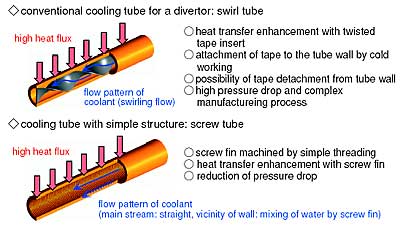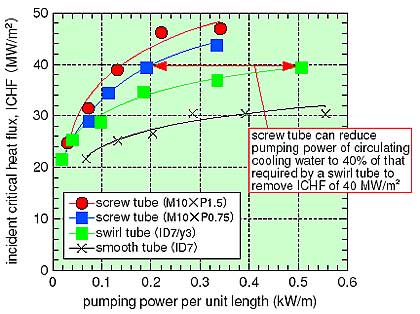The divertor is the only high heat flux component (HHFC) designed to be in contact with plasma in the fusion machine, with a steady state high heat flux of more than 20 MW/m2, which is hardly experienced among the engineering components. For the purpose of heat removal of such high heat flux by water flowing from HHFCs, a high heat transfer efficiency in the phase change of coolant, i.e., boiling, must be utilized. In addition to the high heat removal characteristics of the cooling tube, thermal fatigue data in cyclic heat load conditions are necessary to use a cooling tube for the divertor HHFCs. Therefore, the swirl tube, a tube with a twist tape inserted, is applied to the ITER divertor because its thermal fatigue characteristics have been widely investigated (Fig. 3-11 upper). In the swirl tube, a twist tape is inserted in the tube to generate swirl motion in the coolant, and this might have lead some disadvantages including the tape's detachment and a relatively high pressure drop. To remove these deficiencies in the cooing tube, a screw tube is proposed (Fig. 3-11, lower). In the screw tube, a tube wall is machined into a nut-like surface by simple threading, which can augment mixing or replacement of the coolant adjacent to the tube surface to enhance the heat removal performance.
The incident critical heat flux (ICHF) is an important limit when designing heat removal components in which boiling occurs. Exceeding this limit causes the replacement of liquid adjacent to the tube surface by a vapor blanket. This blanket acts as a heat flow barrier from the wall to the coolant, which results in catastrophic failure (burnout or melting) of the component. In general, to attain a high value of ICHF, one can increase the flow rate. However, a higher flow rate needs higher energy to circulate the water, that is, larger pumping power. From the viewpoint of the pumping power, various types of screw tube have been tested and compared with other tubes as shown in Fig. 3-12. The screw tube with M10 thread has the highest ICHF value and the pumping power to obtain an ICHF of 40 MW/m2 is reduced to less than 40% of that for the swirl tube with inner diameter of 7 mm and a twist ratio of three. These research activities indicate that the screw tube has a high potential to achieve a high performance cooling tube with less pumping power. These activities are being pursued to investigate the thermal fatigue behavior of the screw tube under cyclic high heat load conditions for the purpose of demonstrating its reliability for its application to HHFCs. |

